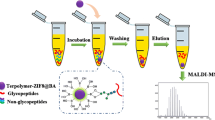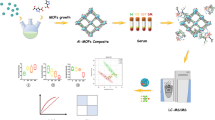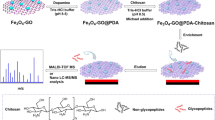Abstract
A three-step strategy is introduced to develop inherent iminodiacetic (IDA)-functionalized nanopolymer. SEM micrographs show homogenous spherical beads with a particle size of 500 nm. Further modification to COOH-functionalized 1,2-epoxy-5-hexene/DVB mesoporous nanopolymer enriches glycopeptides via hydrophilic interactions followed by their MS determination. Significantly high BET surface area 433.4336 m2 g−1 contributes to the improved surface hydrophilicity which is also shown by high concentration of ionizable carboxylic acids, 14.59 ± 0.25 mmol g−1. Measured surface area is the highest among DVB-based polymers and in general much higher in comparison to the previously reported BET surface areas of co-polymers, terpolymers, MOFs, and graphene-based composites. Thirty-one, 19, and 16 N-glycopeptides are enriched/identified by nanopolymer beads from tryptic digests of immunoglobulin G, horseradish peroxidase, and chicken avidin, respectively, without additional desalting steps. Material exhibits high selectivity (1:400 IgG:BSA), sensitivity (down to 0.1 fmol), regeneration ability up to three cycles, and batch-to-batch reproducibility (RSD > 1%). Furthermore, from 1 μL of digested human serum, 343 N-glycopeptide characteristics of 134 glycoproteins including 30 FDA-approved serum biomarkers are identified via nano-LC–MS/MS. The developed strategy to self-generate IDA on polymeric surface with improved surface area, porosity, and ordered morphology is insignia of its potential as chromatographic tool contributing to future developments in large-scale biomedical glycoproteomics studies.
Graphic abstract





Similar content being viewed by others
Data availability
Data is available via the ProteomeXchange with identifier PXD027783.
References
He XM, Liang XC, Chen X, Yuan BF, Zhou P, Zhang LN, Feng YQ (2017) High strength and hydrophilic chitosan microspheres for the selective enrichment of N-glycopeptides. Anal Chem 89(18):9712–9721
Wang Y, Liu M, Xie L, Fang C, Xiong H, Lu H (2014) Highly efficient enrichment method for glycopeptide analyses: using specific and nonspecific nanoparticles synergistically. Anal Chem 86(4):2057–2064
Gadekar A, Bhowmick S, Pandit A (2020) A glycotherapeutic approach to functionalize biomaterials-based systems. Adv Funct Mater 30(44):1910031
Liu L, Yu M, Zhang Y, Wang C, Lu H (2014) Hydrazide functionalized core–shell magnetic nanocomposites for highly specific enrichment of N-glycopeptides. ACS Appl Mater Interfaces 6(10):7823–7832
Chen G, Fang XA, Chen Q, Zhang JG, Zhong Z, Xu J, Zhu F, Ouyang G (2017) Boronic acid decorated defective metal–organic framework nanoreactors for high-efficiency carbohydrates separation and labeling. Adv Funct Mater 27(38):1702126
Bi C, Jiang R, He X, Chen L, Zhang Y (2015) Synthesis of a hydrophilic maltose functionalized Au NP/PDA/Fe3O4-RGO magnetic nanocomposite for the highly specific enrichment of glycopeptides. RSC Adv 5(73):59408–59416
Bibi A, Ju H (2016) Efficient enrichment of glycopeptides with sulfonic acid-functionalized mesoporous silica. Talanta 161:681–685
Sun N, Wu H, Shen X, Deng C (2019) Proteomics: nanomaterials in proteomics (Adv. Funct. Mater. 26/2019). Adv Funct Mater 29(26):1970182
Cao L, Yu L, Guo Z, Shen A, Guo Y, Liang X (2014) N-glycosylation site analysis of proteins from Saccharomyces cerevisiae by using hydrophilic interaction liquid chromatography-based enrichment, parallel deglycosylation, and mass spectrometry. J Proteome Res 13(3):1485–1493
Li Q, Xie Y, Wong M, Lebrilla C (2019) Characterization of cell glycocalyx with mass spectrometry methods. Cells 8(8):882
Fang C, Xiong Z, Qin H, Huang G, Liu J, Ye M, Feng S, Zou H (2014) One-pot synthesis of magnetic colloidal nanocrystal clusters coated with chitosan for selective enrichment of glycopeptides. Anal Chim Acta 841:99–105
Huang G, Xiong Z, Qin H, Zhu J, Sun Z, Zhang Y, Peng X, Ou J, Zou H (2014) Synthesis of zwitterionic polymer brushes hybrid silica nanoparticles via controlled polymerization for highly efficient enrichment of glycopeptides. Anal Chim Acta 809:61–68
Ji Y, Xiong Z, Huang G, Liu J, Zhang Z, Liu Z, Ou J, Ye M, Zou H (2014) Efficient enrichment of glycopeptides using metal–organic frameworks by hydrophilic interaction chromatography. Analyst 139(19):4987–4993
Wang Y, Wang J, Gao M, Zhang X (2015) An ultra-hydrophilic dendrimer-modified magnetic graphene with a polydopamine coating for the selective enrichment of glycopeptides. J Mater Chem B 3(44):8711–8716
Jiang H, Han L, Lin P, Wang Z, Jang MH, Wu Q, Xia Q (2016) Sub-10 nm Ta channel responsible for superior performance of a HfO2 memristor. Sci Rep 6:28525
Zhu H, Li X, Qu J, Xiao C, Jiang K, Gashash E, Liu D, Song J, Cheng J, Ma C, Wang PG (2017) Diethylaminoethyl sepharose (DEAE-sepharose) microcolumn for enrichment of glycopeptides. Anal Bioanal Chem 409(2):511–518
Wang H, Jiao F, Gao F, Huang J, Zhao Y, Shen Y, Zhang Y, Qian X (2017) Facile synthesis of magnetic covalent organic frameworks for the hydrophilic enrichment of N-glycopeptides. J Mater Chem B 5(22):4052–4059
Wan H, Huang J, Liu Z, Li J, Zhang W, Zou H (2015) A dendrimer-assisted magnetic graphene–silica hydrophilic composite for efficient and selective enrichment of glycopeptides from the complex sample. ChemComm 51(45):9391–9394
Zauner G, Koeleman CA, Deelder AM, Wuhrer M (2010) Protein glycosylation analysis by HILIC-LC-MS of proteinase K-generated N-and O-glycopeptides. J Sep Sci 33(6–7):903–910
Shao W, Liu J, Yang K, Liang Y, Weng Y, Li S, Liang Z, Zhang L, Zhang Y (2016) Hydrogen-bond interaction assisted branched copolymer HILIC material for separation and N-glycopeptides enrichment. Talanta 158:361–367
Qing G, Li X, Xiong P, Chen C, Zhan M, Liang X, Sun T (2016) Dipeptide-based carbohydrate receptors and polymers for glycopeptide enrichment and glycan discrimination. ACS Appl Mater Interfaces 8(34):22084–22092
Mohamed MH, Wilson LD (2012) Porous copolymer resins: tuning pore structure and surface area with non-reactive porogens. Nanomater 2(2):163–186
Lei L, Liu X, Li Y, Cui Y, Yang Y, Qin G (2011) Study on synthesis of poly (GMA)-grafted Fe3O4/SiOX magnetic nanoparticles using atom transfer radical polymerization and their application for lipase immobilization. Mater Chem Phys 125(3):866–871
Song XJ, Hu J, Wang CC (2011) Synthesis of highly surface functionalized monodispersed poly (St/DVB/GMA) nanospheres with soap-free emulsion polymerization followed by facile “click chemistry” with functionalized alkylthiols. Colloids Surf A Physicochem Eng Asp 380(1–3):250–256
Sun N, Wu H, Chen H, Shen X, Deng C (2019) Advances in hydrophilic nanomaterials for glycoproteomics. ChemComm 55(70):10359–10375
Krokhin O, Ens W, Standing KG, Wilkins J, Perreault H (2004) Site-specific N-glycosylation analysis: matrix-assisted laser desorption/ionization quadrupole-quadrupole time-of-flight tandem mass spectral signatures for recognition and identification of glycopeptides. Rapid commun Mass Spectrom 18(18):2020–2030
Anderson NL (2010) The clinical plasma proteome: a survey of clinical assays for proteins in plasma and serum. Clin Chem 56(2):177–185
Funding
This work is supported by the Higher Education Commission (HEC) of Pakistan.
Author information
Authors and Affiliations
Corresponding author
Ethics declarations
Conflict of interests
The authors declare no competing interests.
Additional information
Publisher's note
Springer Nature remains neutral with regard to jurisdictional claims in published maps and institutional affiliations.
Supplementary Information
Below is the link to the electronic supplementary material.
Rights and permissions
About this article
Cite this article
Sajid, M.S., Saleem, S., Jabeen, F. et al. Iminodiacetic acid (IDA)-generated mesoporous nanopolymer: a template to relate surface area, hydrophilicity, and glycopeptides enrichment. Microchim Acta 188, 417 (2021). https://doi.org/10.1007/s00604-021-05074-8
Received:
Accepted:
Published:
DOI: https://doi.org/10.1007/s00604-021-05074-8




